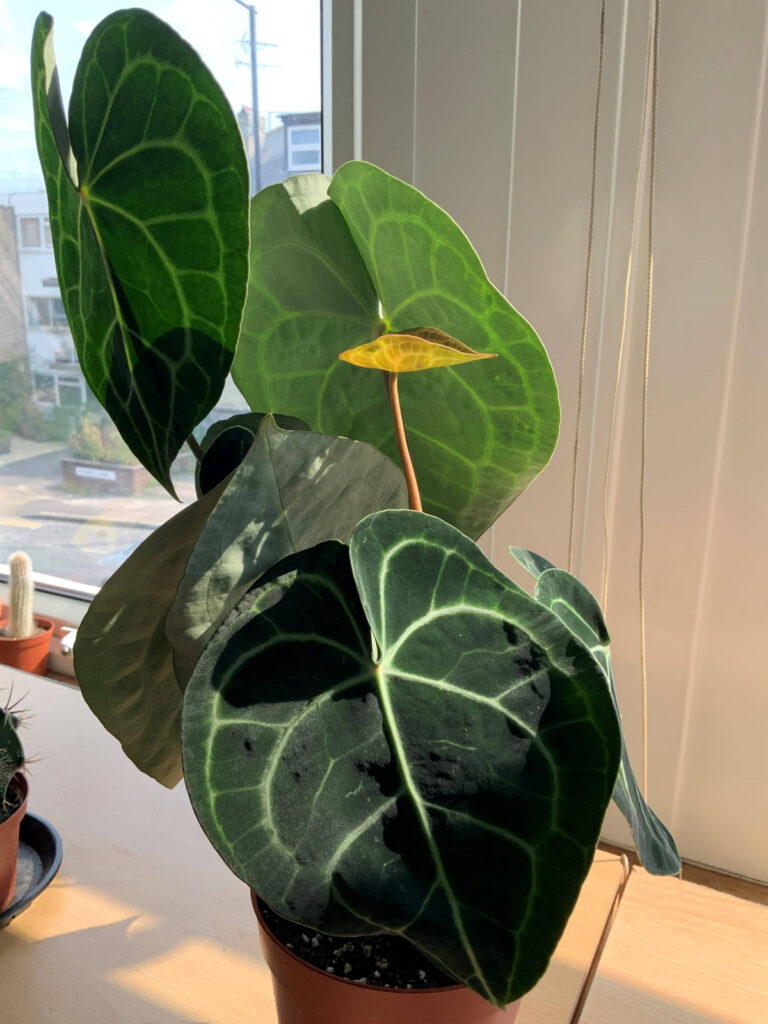No products in the basket.
Plants Blog
How to care for Anthurium
Anthurium is an exotic houseplant with large, green leaves and wonderful colorful flowers. It is beautiful, but it can be troublesome to grow. See how anthurium care in a pot looks like, how to properly water and fertilize anthurium, and when is the best time to replant anthurium. Here are all the secrets of anthurium care that will keep your plant healthy and blooming!
Anthurium is an evergreen plant that comes mainly from the Amazon basin. In apartments, the following are grown as potted plants:
Scherzer’s Anthurium (Anthurium scherzerianum) – valued for its beautiful flowers that can be admired from spring to autumn, and a single flower lasts up to two months. The inflorescence is composed of a magnificent, waxy red sheath and an orange bulb emerging from it. Leaves slightly pointed, dark green and very large (up to 18 cm long).
Andrey’s Anthurium (Anthurium andreanum) – has very interesting heart-shaped leaves with a clearly visible veining. Heart-shaped flower sheaths, very shiny, look lacquered.
Charming Anthurium (Anthurium crystallinum) – has beautiful heart-shaped leaves, very large, reaching up to 40 cm in length and 30 cm in width, embedded also on long petioles. Young leaves are slightly purple, while the older ones are dark emerald with silver veins. Green flowers, small, but also pretty, look inconspicuous next to huge leaves.
Anthurium – care
Proper care for anthurium requires providing the plant with a bright position, but not directly exposed to sunlight (leaves are burned in bright sunlight). Plants tolerate light shade well and cope well with windows facing north. On the south side, it is better to place the anthurium pot a little further from the window so that the light is filtere
In the period from spring to the end of summer, anthurium grows and blooms intensively, and in winter it goes into a state of rest. In summer, the temperature for anthuriums should be close to normal room temperature, i.e. around 21 ° C. In winter, the temperature should be lowered to around 16-18 ° C. The exception is Scherzer anthurium, which in January-February should be cooled at 10-12 ° C to initiate the inflorescences for spring flowering.
Warning! Anthuriums hate cold soil, so never put a pot directly on marble or metal window sills or on a tiled floor. This love of warm soil makes anthurium grow surprisingly well in some people on a warm window sill above a radiator, as long as the air is not too dry.
When caring for anthurium, it is also worth ensuring that flower shoots have supports. They can be gently tied to thin bamboo poles or rested on ladder-shaped supports.
When carrying out care work with anthurium, be careful and put gloves on your hands, because anthuria is poisonous potted plants – they can irritate the skin of the hands and, if swallowed, cause swelling of the lips, tongue and throat. Fortunately, the concentration of poisonous substances in anthurium is very low and the unpleasant symptoms usually pass quickly.
Anthurium – watering and fertilizing
It is very important to water the anthurium properly. During the growing season, we water it every few days so that the soil is constantly moist but not too wet. It is also worth sprinkling the leaves daily. However, you should not wipe the leaves with a damp cloth, as they are easy to damage.
Cold tap water is not suitable for watering anthuriums. Soft, wet water with a temperature equal to the temperature in the room where anthurium grows will be better. Hard water with high calcium content and chlorinated water should be avoided because it causes brown spots on anthurium leaves. Watering the anthurium in winter is limited.
Good to know! Anthuriums require high air humidity, so it is worth placing them in a group with other plants. Another way is to place a flat container with pebbles next to the plant, which is poured with water every day.
We fertilize anthurium during the growing season – from spring to the end of summer, using liquid fertilizer diluted in water for watering every two weeks. Florovit fertilizer for potted plants or natural biohumus works well. Anthurium likes acidic soil, with a pH of 4.5-5.5, so we can also fertilize them with fertilizers for acidophilic plants.
Fertilization of potted plants Fertilization of potted plants
Fertilization of potted plants is an important care procedure, affecting the abundance of flowering, leaf color and plant growth rate, as well as their health and general condition. When is potted plants fertilized, how to dose the fertilizers and which ones are the best? Here’s everything you need to know about fertilizing houseplants.

